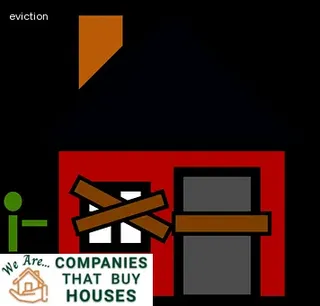The eviction process in Ohio varies depending on the county and can be a lengthy process. Generally, landlords and property managers must first provide their tenants with a termination notice before filing an eviction lawsuit.
Depending on the type of notice provided, the tenant may have anywhere from three to 30 days to vacate the premises or respond to the notice. After this period has expired, landlords or property managers can file an eviction lawsuit in court.
In most cases, tenants will then have five days to respond to the complaint before a hearing is held by the court. If a judgement is made in favor of the landlord, tenants will have up to five days to appeal or vacate the property.
Once this period has expired, landlords or property managers may file a writ of possession with the court which allows them to take back possession of their property if necessary. The entire eviction process typically takes anywhere from two weeks up to several months depending on various factors such as whether an appeal was filed or if there were any delays in processing documents.

In Ohio, evictions can be pursued for a variety of reasons. Some of the most frequent are failure to pay rent, violation of the lease agreement, or engaging in illegal activities on the property.
If a tenant is late with rent payments or has not paid at all, then the landlord has the right to initiate an eviction process. Tenants may also be evicted if they violate terms of the lease agreement, such as having unauthorized occupants or pets living in the rental unit, or breaking noise ordinances or other laws.
Additionally, if tenants are found to be engaging in illegal activities - such as drug-related crimes - then landlords are allowed to file for eviction proceedings. It is essential that landlords and property managers understand their legal rights and obligations when it comes to evicting tenants in Ohio so that they can proceed with confidence and protect their interests.
The process of filing a complaint for eviction in Ohio can be complicated, so it's important to understand the laws and procedures involved. The first step is to notify the tenant in writing that they are being evicted.
This must include specific details about why the tenant is being asked to leave and provide them with a set amount of time to do so. After this notice has been delivered, the landlord or property manager must file a complaint in court.
The complaint must include information such as the name of the tenant and reason for eviction, as well as any evidence that supports the case. Once filed, the court will set a hearing date where both parties can present their arguments and evidence before a judge.
Depending on the response from each side, the judge will then decide whether or not an eviction order should be issued. If an order is granted, it can take anywhere from 30-45 days for an eviction to be completed in Ohio.

Serving a tenant with a notice to comply is an important step in the eviction process in Ohio. Before initiating the eviction process, it is crucial that the landlord or property manager properly serves the tenant with a notice to comply.
This notice informs the tenant of the violation and outlines how they can remedy it. In most cases, this involves correcting a breach of contract such as failing to pay rent on time or having unauthorized occupants living in the rental unit.
In Ohio, landlords must serve tenants with a written notice that gives them at least three days to fix the issue. Depending on how quickly the tenant complies, this could provide them additional time to stay in their rental unit.
If they do not correct the violation within three days, then landlords can proceed with filing for eviction in court.
When it comes to eviction in Ohio, landlords and property managers must understand the process of asking for possession. Before a landlord can access the court system, they must provide a written notice that gives tenants an opportunity to leave the premises within three days.
If the tenant does not vacate the property by this date, the landlord may then file a complaint with the court to begin an eviction lawsuit. Once filed, a summons will be issued by the court to inform the tenant that they are being sued for eviction.
The tenant will then have 28 days from the time of service to answer and submit their response in writing to dispute any claims made by the landlord or property manager. It is possible for either party involved in an eviction situation to request a jury trial if needed and if granted, this could extend how long an eviction takes in Ohio.

Once an eviction order is granted in Ohio, landlords and property managers can take possession of the property. However, this process can take anywhere from a few days to several weeks, depending on the situation.
The time frame also depends on if the tenant has vacated voluntarily or if other legal proceedings are taking place to evict them. Landlords should be aware that they cannot change locks without prior authorization from the court.
In addition, they must provide a written notice to vacate before filing a complaint with the court and follow specific procedures when collecting rent and serving notices to tenants. It is important for both landlords and tenants to be aware of the laws governing evictions in Ohio so that they understand their rights and responsibilities throughout the entire eviction process.
Presenting evidence in an eviction case is critical for Ohio landlords and property managers to understand the timeline of an eviction. Ohio law requires landlords to provide a written notice before filing a complaint with the court that lists the reasons why they are seeking eviction.
Once a complaint has been filed, both parties will have an opportunity to present their case at trial. Landlords should be prepared to present witnesses, documents, or other evidence that support their claim for eviction.
Evidence might include lease agreements, rent payment records, contracts, photographs, or emails between landlord and tenant that demonstrate how the tenant violated the terms of the lease. Evidence presented at trial will help determine the outcome of an eviction case in Ohio.

In Ohio, landlords and property managers should understand the difference between terminating a tenant with cause versus without cause. With cause terminations typically occur when the lease agreement has been violated, such as not paying rent or causing a nuisance.
In this situation, the landlord can serve their tenant with an eviction notice, which must be served no earlier than three days after the tenant's breach of contract. The tenant then has seven days to remedy the situation or vacate the premises.
For without-cause evictions, in most cases tenants are given 30 days notice to vacate. However, in areas where rent control is in effect and the tenant has resided on the property for 12 consecutive months or longer, they must be provided with 90 days notice instead.
Regardless of whether it's a with-cause or without-cause eviction, any proceedings must be carried out through court proceedings if the tenant refuses to comply with either type of notice. This means that landlords and property managers must file an eviction lawsuit and have it approved by a judge before they can legally remove their tenant from their premises.
Tenant defenses against an Ohio eviction action are limited due to the strict laws in the state. The most common defense is that the tenant has paid all rent and other charges owed to their landlord or property manager.
If this is not possible, tenants may raise other defenses such as lack of proper notice being given by the landlord, a breach of warranty of habitability due to poor living conditions, or discrimination based on protected classes. Tenants should be aware that if they choose to contest an eviction action, they must appear in court and present their defense.
Failure to appear can result in a default judgment for the landlord. Tenants should also be aware that their defenses will only delay an eviction action and will not necessarily stop it from occurring - landlords are still able to win evictions in almost all cases even with tenant defenses raised.

Once a court order is issued to evict a tenant in Ohio, the landlord or property manager must take additional steps to remove the tenant from the property. First, the sheriff's office must be notified of the eviction and will schedule a date to execute the writ of possession.
On that day, the sheriff's deputies will arrive at the rental property and supervise as movers physically remove all of the tenant's belongings from inside. This process usually takes between two and four hours depending on how much stuff needs to be moved.
The landlord or property manager should also alert any locksmiths needed for changing locks and updating security systems on this day as well. Once all of these steps are complete, the eviction process is finished and access to the rental property is restored to the landlord or property manager.
In Ohio, eviction proceedings are subject to certain laws and regulations. This is done to ensure that landlords and property managers are able to protect their investments while also providing tenants with a fair process.
The Ohio Landlord Tenant Act outlines the legal steps that must be taken when evicting a tenant in the state. These steps include giving proper notice to the tenant, filing an eviction complaint in court, and obtaining a writ of possession if the eviction is approved.
Knowing these rules allows landlords and property managers to understand the rationale behind them so they can better prepare for any potential challenges during an eviction process. Additionally, understanding the timeline of an eviction in Ohio is essential as it helps landlords and property managers know how long they may have to wait before a tenant is removed from their property.

In Ohio, the eviction process is typically a relatively lengthy one, with timelines that can vary greatly depending on the circumstances. For landlords and property managers looking to estimate how long does an eviction take in Ohio, it is important to understand the various steps involved.
First, the tenant must be served with a written notice to vacate, followed by a court filing. If the tenant fails to respond after being served, the landlord or property manager will then need to schedule a hearing in front of a judge.
If all parties attend the hearing and agree on an outcome, such as voluntary surrender of the premises or judgement for possession awarded in favor of the landlord, then no further proceedings are necessary. However, if either party disagrees or fails to appear at the court hearing then there may be additional hearings held before a final decision is made.
The length of time needed for each step in this process can depend on several factors including how promptly each step is completed, any extenuating circumstances like delays due to COVID-19 related regulations or holidays, and whether either party appeals any decisions made by the court. Ultimately though, landlords and property managers should expect that an eviction process in Ohio could take anywhere from several weeks up to several months depending on these various factors.
When it comes to eviction in Ohio, the timeline for tenants to vacate their property can vary. Generally, landlords and property managers can expect that after a tenant refuses to leave the premises, an eviction process may take approximately three weeks.
The tenant will be notified of the court date via a Summons, which they typically receive within five days of filing. Once the court date is set, a judge will hear both sides and then determine whether or not the tenant must vacate.
The tenant will have seven days from when the judge issues their ruling to leave the property; otherwise, a sheriff or marshal may be called to forcibly remove them from the premises. It’s important for landlords and property managers to understand that evicting a tenant in Ohio is not always a quick process as there are several steps involved before they are legally allowed to enter and take possession of their rental unit again.

In Ohio, landlords and property managers must follow a legal process when evicting tenants. One important step in the process is serving a written notice of eviction, usually known as a “Notice to Vacate”.
Typically, the landlord must give the tenant 30 days to vacate after they receive the notice. This timeline is set by Ohio law and cannot be shortened without an order from a court.
However, if the tenant fails to leave within those 30 days, then a landlord can file an eviction lawsuit in court which can significantly reduce the amount of time it takes for an eviction to be completed in Ohio.
After a 3-day eviction notice is served in Ohio, the tenant has three days to vacate the property or face possible legal action. If they fail to comply with the notice, the landlord can then file an eviction complaint with the court.
The court will then issue a summons to the tenant and set a hearing date. At this point, both parties are given time to present their case before a judge who will ultimately decide if the eviction will proceed.
The ruling could take anywhere from 15 to 30 days, depending on how busy the court is or if either party requests an extension. Once granted by a judge, the tenant must comply with all orders within 24 hours or face additional penalties such as fines and jail time.
The entire process from start to finish typically takes about 1-2 months but may vary depending on specific circumstances.
Delaying an eviction in Ohio is possible, but it should be done carefully. Landlords and property managers must understand the eviction process before attempting to delay it.
Generally, a landlord or property manager must first serve the tenant with a written notice that includes the reasons for eviction. The tenant then has three days to move out or contest the eviction.
If they choose to contest it, their case will be heard by a court. A hearing date is usually set within 10-20 days of the initial notice, depending on local county laws.
In some cases, this hearing date may be pushed back further if the tenant can demonstrate that they need additional time to prepare for their defense. Landlords and property managers should also note that in most cases, tenants cannot be evicted during certain times such as holidays or weekends.
It’s important that landlords and property managers are aware of all relevant laws before attempting to delay an eviction in Ohio.